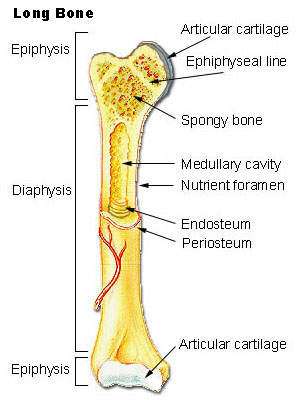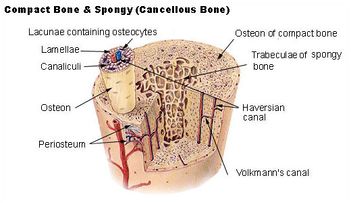Bone
Original Editors -
Top Contributors - Lucinda hampton, Candace Goh, Admin, Shaimaa Eldib, Kim Jackson, Wataru Okuyama, Jess Bell, Robin Tacchetti, George Prudden, Claire Knott, Manisha Shrestha, Khloud Shreif, Sai Kripa, Tony Lowe, Stephanie Geeurickx, WikiSysop and Joao Costa
Introduction[edit | edit source]
Bones are connected to each other to form skeleton - the framework of living tissue that grows, repairs, and renews itself. Under the right conditions, bone tissue undergo a process of mineralization, formed by collagen matrix and hardened by deposited calcium. Bone tissue (osseous tissue) differs greatly from other tissues in the body. Bone is hard and many of its functions depend on that characteristic hardness.[1]
Structure[edit | edit source]
Gross anatomy[edit | edit source]
A long bone has two parts: the diaphysis and the epiphysis. The diaphysis is the tubular shaft that runs between the proximal and distal ends of the bone. The hollow region in the diaphysis is called the medullary cavity, which is filled with yellow marrow. The walls of the diaphysis are composed of dense and hard compact bone.
Individual bone structure[edit | edit source]
- Compact/cortical bone - makes up outer part of bone, rigid, dense, highly organised bone tissue
- Cancellous/spongy bone - makes up inner part of bone, more elastic and porous, storage of bone marrow
Cellular structure[edit | edit source]
- Osteoblasts - produce matrix (osteoid), build up bone tissue
- Osteoclasts - secretes acids and enzymes to breakdown bone tissue
- Osteocytes - maintain bone tissue by mineralising osteoid
Molecular structure[edit | edit source]
Matrix[edit | edit source]
- Inorganic
- Organic - Made up of 90-95% collagen fibres, giving bone its powerful tensile strength.
Woven or lamellar[edit | edit source]
Functions[edit | edit source]
Mechanical[edit | edit source]
- Protect internal organs
- Give shape and support to the body
- Movement
Synthetic[edit | edit source]
- Manufactures blood cells from the bone marrow (hematopoiesis)
Metabolic[edit | edit source]
- Mineral storage
- Fat storage
- Role in acid-base balance
Remodelling[edit | edit source]
Purpose[edit | edit source]
- To allow bone to ordinarily adjust strength in proportion to the degree of bone stress. When subjected to heavy loads, bones will consequently thicken.
- To rearrange shape of bone for proper support of mechanical forces in accordance with stress patterns.
- To replace old bone which may be brittle/weak in order to maintain toughness of bone. New organic matrix is needed as the old organic matrix degenerates.
Calcium homeostasis/balance must exist between osteoclasts and osteoblasts activity[edit | edit source]
- If too much new tissue is formed, the bones become abnormally large and thick (acromegaly)
- Excessive loss of calcium weakens the bones, as occurs in osteoporosis
Repair[edit | edit source]
Disorders[edit | edit source]
- Osteoporosis
- Osteoarthritis
- Osteomalacia
- Rickets
- Epiphyseal plate disorders
References[edit | edit source]
see adding references tutorial[1].
- ↑ 1.0 1.1 Opentextbc.ca. (2018). 6.3 Bone Structure – Anatomy and Physiology. [online] Available at: https://opentextbc.ca/anatomyandphysiology/chapter/6-3-bone-structure/ [Accessed 17 Dec. 2018].
- ↑ Hall JE. Guyton and Hall textbook of medical physiology e-Book. Elsevier Health Sciences; 2015 May 31.








